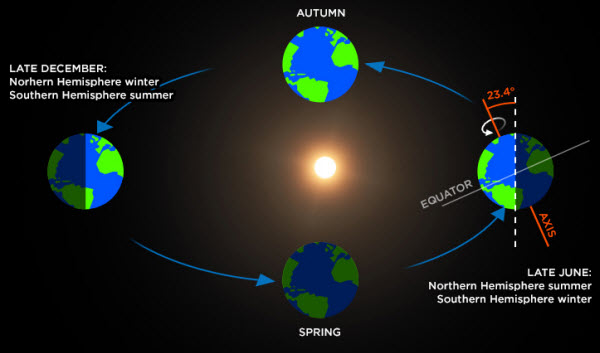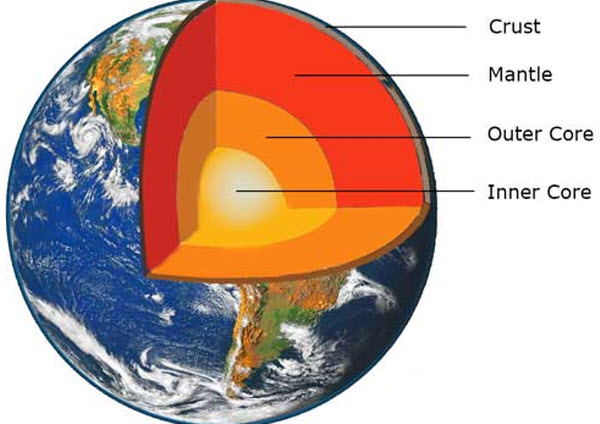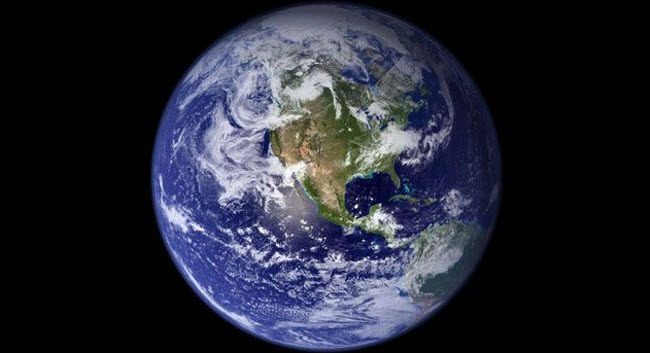Earth is the third planet from the Sun in the solar system and the fifth largest in terms of size. It is the largest of the four terrestrial planets, which also include Mars, Venus, and Mercury. These planets are composed mainly of rocks and metals. Earth is also the densest planet in our solar system and is the only known place in the universe that harbors life. Although large quantities of water are found throughout our solar system, Earth is the only planet that maintains surface water in a liquid state, covering about 71% of its surface. The rest of the planet consists of landmasses, including continents and islands.
The Earth’s surface is divided into tectonic plates that move slowly over time, forming mountain ranges and interacting with each other to produce earthquakes and volcanoes. Earth also generates a unique magnetic field due to its liquid outer core. This magnetic field acts as a protective shield, deflecting harmful solar winds and thereby safeguarding the planet from potential damage. It is estimated that Earth formed about 4.5 billion years ago. In its early years, oceans formed, and life began in the seas before eventually moving onto land. Humans appeared around 300,000 years ago, and today, nearly 8 billion people live on Earth, relying on its natural resources for survival. However, some human activities are detrimental to the planet’s ecosystems, including the climate, soil, and water sources, potentially threatening human life and risking mass extinction.
Why is Earth Called “Earth”?
The name “Earth” is believed to have been coined over a thousand years ago. Unlike other planets, which are named after Greek and Roman deities, Earth is an exception. The name derives from the Germanic word for “ground” or “soil.” Earth has an elliptical shape, which causes the equatorial regions to receive more solar energy than the polar regions. This energy is redistributed by the movement of the oceans and the atmosphere, which is primarily composed of nitrogen and oxygen, along with carbon dioxide that traps some of the Sun’s energy near the surface. Water vapor is also widely present in the atmosphere and forms clouds that cover most of the planet.
The Earth’s climate varies due to factors such as latitude, elevation, and proximity to oceans. Earth has one natural satellite, the Moon, which is about a quarter the size of Earth and helps stabilize the planet’s axial tilt, contributing to phenomena like tides.
Size and Distance of Earth

Earth has a radius of approximately 6,371 kilometers, making it the largest of the terrestrial planets and the fifth-largest overall in the solar system. It is about 150 million kilometers from the Sun, a distance referred to as one astronomical unit (AU). This unit is commonly used to express distances within the solar system. Due to this distance, light from the Sun takes about eight minutes to reach Earth. The Earth is also located about 25,000 light-years from the center of the Milky Way galaxy.
Given that the Earth’s equatorial circumference is about 40,070 kilometers and a day lasts roughly 24 hours, the planet rotates at a speed of approximately 1,670 kilometers per hour at the equator. This rotational speed decreases as you move toward the poles, where it eventually reaches zero.
Orbit and Rotation
As Earth orbits the Sun, it completes one rotation on its axis every 23.9 hours. It takes about 365.25 days to complete one orbit around the Sun. This extra quarter of a day poses a challenge for our calendar system, which typically counts a year as 365 days. To keep our calendar in alignment with Earth’s orbit, we add an extra day every four years, known as a leap day, resulting in a leap year.

Earth’s axis is tilted at an angle of 23.4 degrees, causing sunlight to hit the planet unevenly throughout the year and leading to seasonal variations. For part of the year, the Northern Hemisphere is tilted toward the Sun, resulting in summer, while six months later, the situation reverses. During the spring and fall equinoxes, both hemispheres receive roughly equal amounts of sunlight. The Earth’s surface is often divided into three main climate zones: polar regions near the poles, temperate regions between 23 and 66 degrees latitude, and tropical regions between the Tropic of Cancer and the Tropic of Capricorn.
Formation of Earth
The solar system settled into its current configuration about 4.5 billion years ago, and Earth formed when gravity pulled swirling gas and dust together to create the third planet from the Sun. Like its terrestrial neighbors, Earth has a central core, a rocky mantle, and a solid crust.
Scientists estimate that Earth has gone through four major geological eons. The first, the Hadean Eon, began with the planet’s formation from a cloud of solar nebula. During this time, volcanic outgassing created a primitive atmosphere, but it lacked oxygen, and much of Earth’s surface remained molten. Over time, the surface cooled, forming a solid crust as Earth transitioned to the Archean Eon. This period saw the emergence of single-celled organisms about 3.5 billion years ago. Next came the Proterozoic Eon, during which more complex, multicellular life forms appeared, and bacteria began enriching the atmosphere with oxygen. The current eon, the Phanerozoic, began with the Cambrian explosion around 541 million years ago, which saw the rapid emergence of most major animal phyla. This era continues today, marked by the rise of vertebrates, the spread of plants and animals, and, eventually, humans.
Structure of Earth
Earth is composed of four main layers: the inner core, the outer core, the mantle, and the crust. The inner core is a solid sphere made primarily of iron and nickel with a radius of about 1,221 kilometers. Temperatures in this region can reach up to 5,400 degrees Celsius. Surrounding the inner core is the outer core, a layer about 2,300 kilometers thick made of molten iron and nickel. Above the core lies the mantle, the thickest layer at around 2,900 kilometers, composed of hot, viscous rock. The outermost layer is the crust, averaging about 30 kilometers in thickness, though it is thinner beneath the oceans and thicker on the continents.

Like Mars and Venus, Earth has volcanoes, mountains, and valleys. The lithosphere, which includes the crust and the upper mantle, is divided into massive tectonic plates that move slowly over time. Earthquakes occur when these plates collide or grind against each other. Mountain ranges can form from such collisions. The average depth of the oceans, which cover about 71% of Earth’s surface, is roughly 4 kilometers. The oceans contain almost all of Earth’s volcanoes, so much so that the base-to-peak height of Mauna Kea, a volcano in Hawaii, surpasses that of Mount Everest, though most of Mauna Kea is underwater. The longest mountain range on Earth, the Mid-Atlantic Ridge, is also underwater, stretching across the Arctic and Atlantic Oceans and being four times longer than the Andes, Rockies, and Himalayas combined.
The highest point above sea level is the summit of Mount Everest at 8,849 meters, while the deepest point on the planet is the Mariana Trench in the western Pacific Ocean, which plunges to about 10,984 meters. The Nile River is the longest river on Earth, stretching 6,650 kilometers across northeastern Africa. Lake Baikal in Russia is the world’s largest and deepest freshwater lake, containing approximately 23,013 cubic kilometers of water—about the same volume as all five of North America’s Great Lakes combined.
Earth’s Atmosphere
Earth’s atmosphere consists of about 78% nitrogen, 21% oxygen, and 1% other gases, including argon, carbon dioxide, and neon. The atmosphere influences Earth’s long-term climate and short-term weather, protects us from harmful solar radiation, and serves as a shield against meteoroids, most of which burn up due to friction when entering it. Most human activity takes place in the lowest layer of the atmosphere, the troposphere, which extends from 8 to 14.5 kilometers above sea level. Above it is the stratosphere, reaching up to 50 kilometers, where clouds and weather balloons can be found. Next is the mesosphere, extending up to 85 kilometers, where most meteoroids burn up. The thermosphere is the last layer, stretching into space up to about 600 kilometers above the planet.
Earth’s Magnetic Field

The rapid rotation of Earth and its nickel-iron core generate a magnetic field that protects us from the solar wind, a stream of charged particles emitted by the Sun. When these particles become trapped in Earth’s magnetic field, they collide with air molecules over the magnetic poles, creating the auroras, or northern and southern lights.
Earth’s magnetic field is the reason compasses point toward the magnetic north pole. However, the magnetic poles can reverse, with the north and south poles swapping places. Geological records indicate that these magnetic reversals occur approximately every 400,000 years. As far as we know, such a reversal poses no threat to life on Earth and is not expected to occur for at least another thousand years. However, when it does happen, compass needles could point in different directions for a few centuries during the transition before finally settling in the opposite direction.
Life on Earth
Earth has the perfect conditions for life, including a suitable temperature range and a mix of chemicals that make life possible. It is unique because most of its surface is covered in liquid water, which has persisted for long periods, providing a stable environment for life to evolve. The vast oceans were likely the cradle of life around 3.8 billion years ago. However, the features that make Earth habitable are changing due to ongoing climate change and global warming.
Exploring Earth

Although reaching outer space poses significant challenges, exploring Earth
itself is less difficult. From the depths of the ocean to the highest mountains and from the equator to the poles, Earth has been extensively explored and mapped. Over the past few centuries, explorers have reached almost every corner of the planet, studying its diverse climates and ecosystems. Yet, despite this extensive exploration, many questions remain unanswered. Scientists continue to investigate the Earth’s natural resources, ecosystems, and the effects of human activity on its climate and geology.
Conclusion
Earth is a unique and dynamic planet that has evolved significantly since its formation 4.5 billion years ago. It is the only known place in the universe that harbors life, and its complex systems support diverse ecosystems. However, human activities are rapidly altering the planet’s climate and ecosystems, posing significant challenges for the future. To ensure a sustainable future, it is essential to understand Earth’s intricate systems and their interdependencies and to act responsibly to mitigate our impact on the planet.
